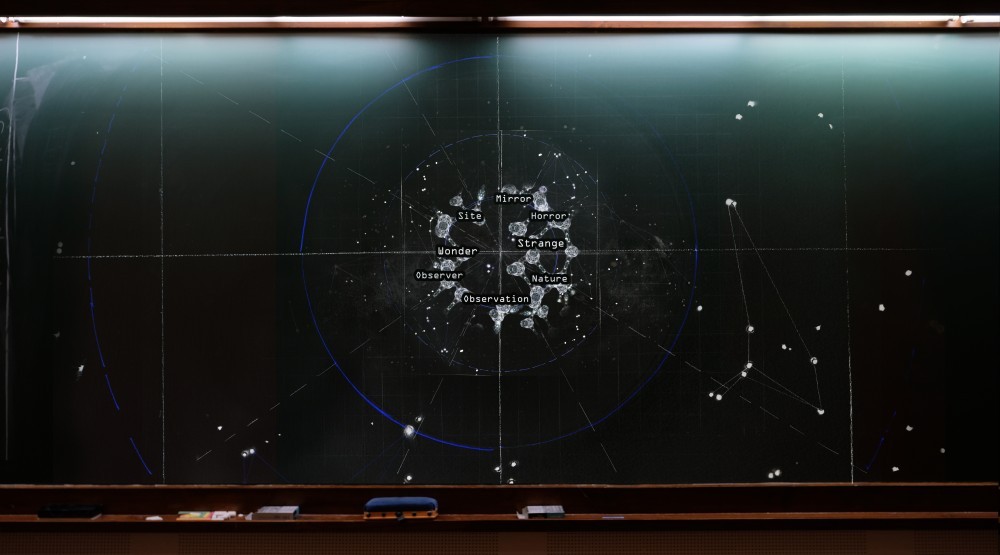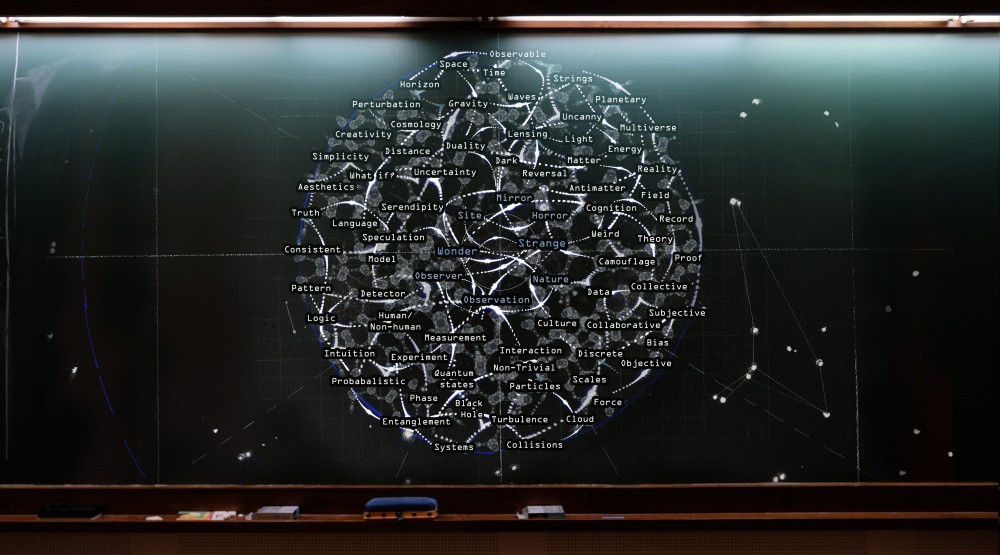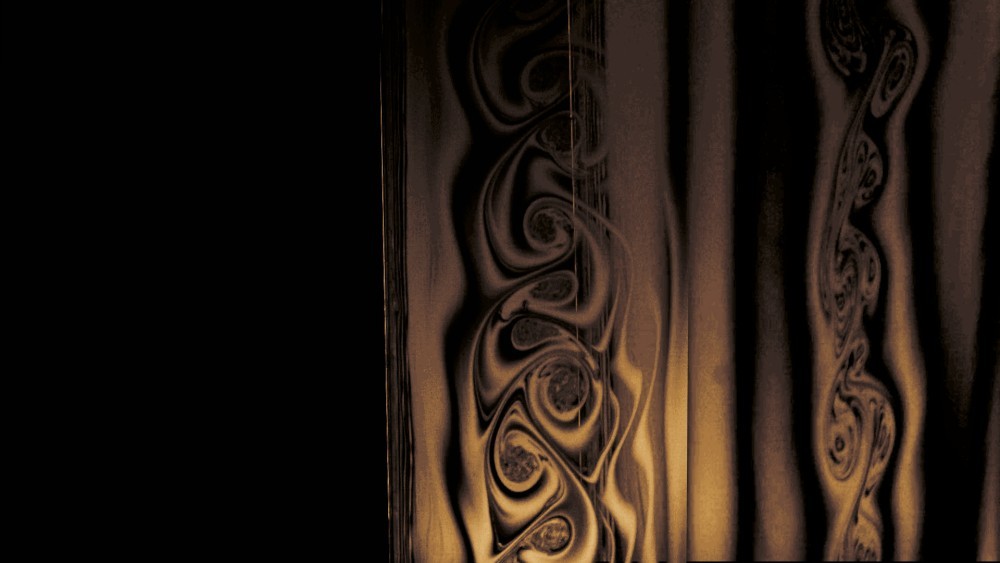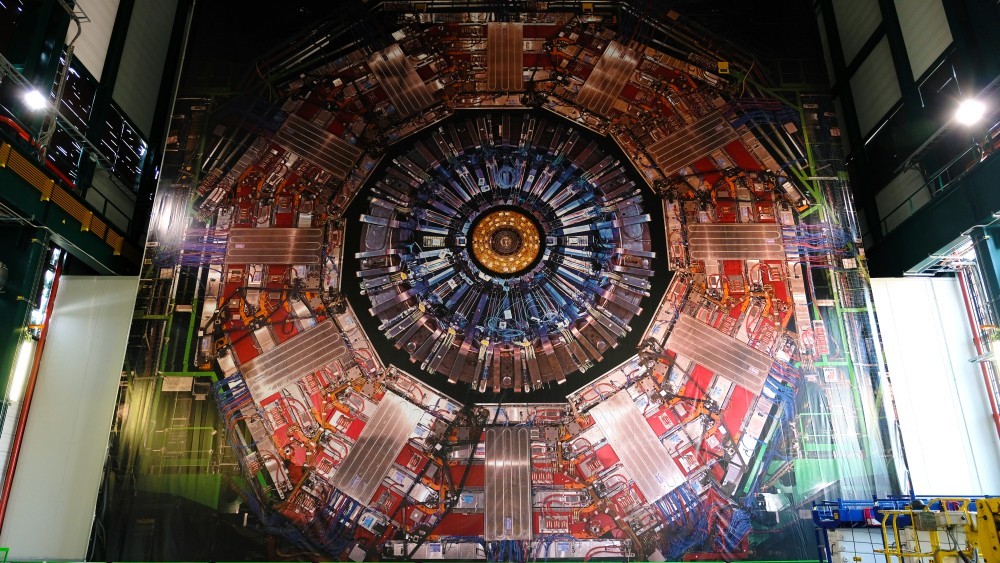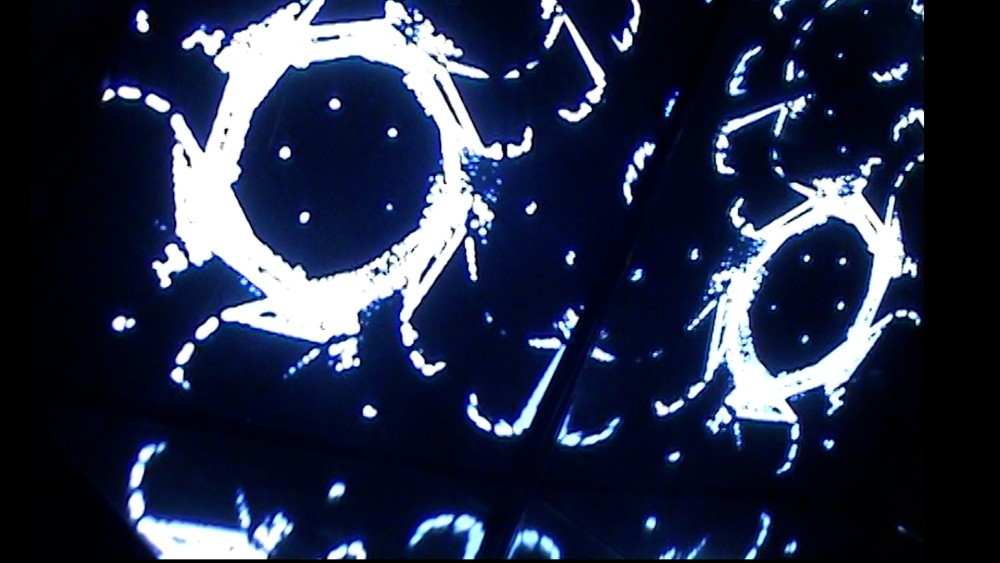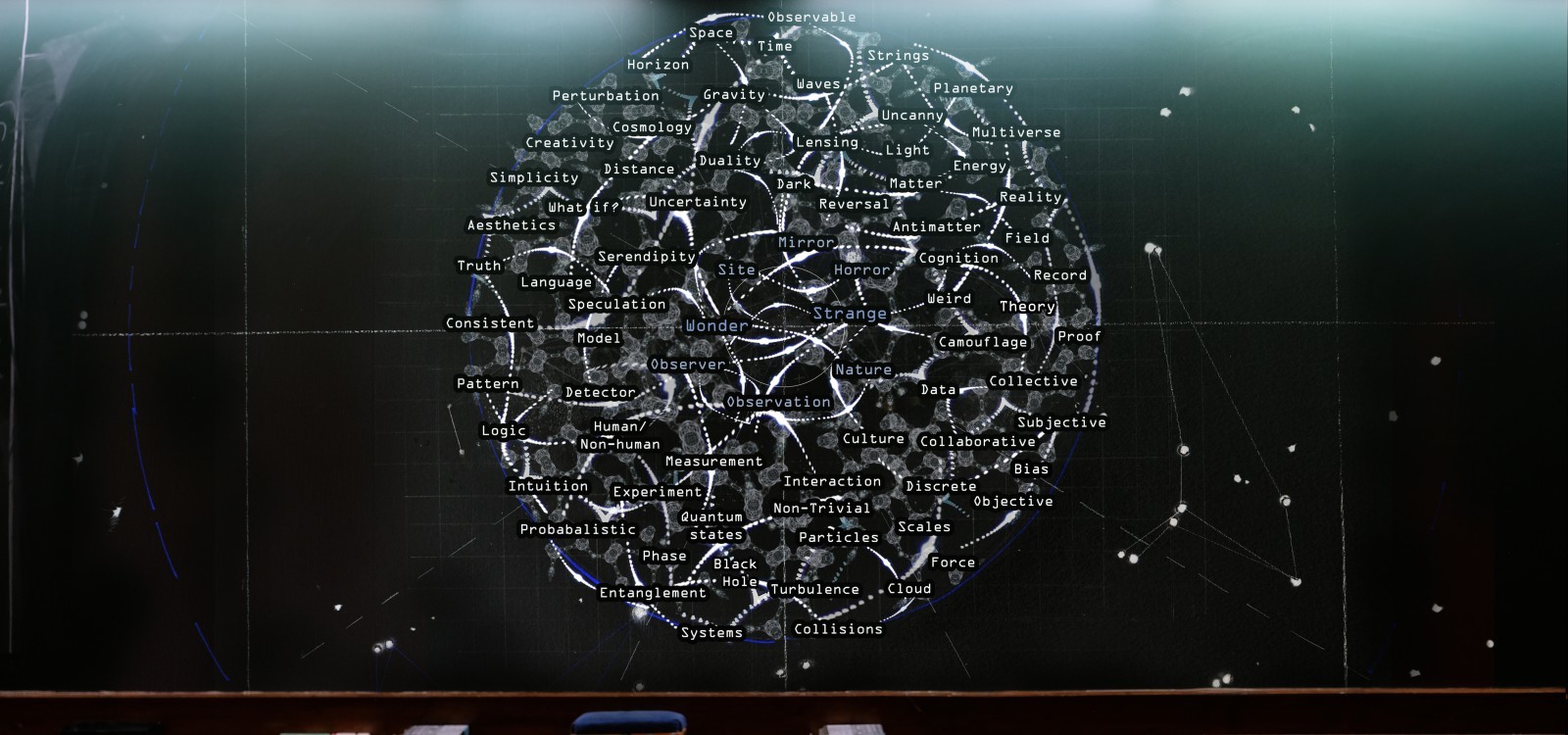
Rohini Devasher’s ‘In a Mirror Darkly: Beyond the Standard Model’
In this essay, artist Rohini Devasher outlines the first iteration of a new Standard Model, based on her ongoing artistic research and developed during her Connect India residency at CERN and ICTS
The laws of physics are different when reflected in a mirror. Things can happen in the mirror that cannot happen in our world. If you take a video of particle interactions and a video of those same interactions reflected in a mirror, you could tell, even at the most fundamental level, whether you were looking at the original or something reflected. It is not what we call parity invariant; it violates parity. This is the deepest fact about the Standard Model; I think it’s different when reflected in a mirror. Mathematically that’s the fact that has the most consequence because it is hard to write down theories that are not reflection invariant.
David Tong, University of Cambridge / CERN
This essay outlines the first iteration of a new model – a diagram or a map with many possible paths towards configurations of research/practice that have yet to coalesce. To understand this new model, it must be read in juxtaposition with the model that preceded it. Let us call this the Standard Model, within which the initial proposal for the Connect India residency fell.
The Standard Model1 of my practice is the theory that describes two frames: wonder and the strange (which may extend to horror) focusing on the role of observation, the observer and the field or site. Developed over the past 14 years through my work with amateur astronomers across India, the current formulation was finalised in the early 2020s upon experimental confirmation in research spaces, observatories, eclipse chases, and conversations with astronomers, astrophysicists, historians of science, etc.
Since then, I have become increasingly aware of the multiplicity of practices of looking (how attention is focused, what is looked at, how it is looked at, and why) and seeing (ways of describing, collecting, sorting, mapping and measuring).
A recognition of the deep strangeness and entanglement of relationships in the natural world, human/non-human, nature/culture, perception/production, have added further credence to the Standard Model. The model has also proven to be intuitive, pointing to subtle properties of mirroring and patterns across disparate spheres.
Since concluding the Connect India residency at the International Centre for Theoretical Science (ICTS) in Bengaluru and at CERN, the European Laboratory for Particle Physics in Geneva, my Standard Model has undergone several crucial developments, continuing changes which have proven necessary to expand its scope to explore better emerging connections and patterns across the new parameters and frames of reference that the residency has revealed.
This new model, which we can call Beyond the Standard Model,2 adds to the Standard Model in a way that maintains consistency with existing frames, yet extends it exponentially to propose new modes and methodologies of research and practice.
Reading connections and patterns across and between points and frames.
All points and frames are in superposition, constantly in play and have the potential to influence each other.
Dualities, or two different descriptions of the same system, are of particular interest.
What follows are the first of many proposed entanglements. The shape and form of these will include video, drawing, prints, writing, sound, and images.
Clouds ⇄ Turbulence ⇄ Fluid Dynamics ⇄ Quantum Field Theory
At ICTS, I had several conversations with Professors Rama Govindrajan and Vishal Vasan on the complexities of fluid dynamics and turbulence, and why clouds are thought to cause the most significant uncertainty in climate predictions. This is because it is extremely challenging to solve fluid-motion equations for clouds. At CERN, I spoke with particle physicist David Tong, who is working on the link between fluid dynamics, as applied to the Earth’s atmosphere and oceans, and topological insulators using the language of quantum field theory.
Professor Rama and her colleagues also focus on a small section of clouds, a cloud box, to try to solve equations for the droplets in that box. At CERN, the CLOUD experiment creates the cleanest box in the world to try to simulate atmospheric conditions between ground level and the stratosphere to study the impact of galactic cosmic rays on cloud formation.
I have been a cloud watcher for many years and have spent much of that time documenting clouds and the history of their observation. I am interested in these new emerging patterns in the study of clouds, cosmic rays, aerosols and fluid dynamics.
Observer ⇄ Detector ⇄ Human/Non-Human ⇄ Observation ⇄ Measurement ⇄ Interaction
At the beginning of the project, one of the things I was keen on exploring was the role of the observer in fundamental physics. After many conversations both at ICTS and at CERN, it is clear that the observer takes both human and non-human forms. Depending on what we choose to look at, for instance, quantum entanglement or collider physics, gravitational waves or string theory, it is also a boundary that is not fixed but rather shifting.
On the non-human side, the detectors at CERN are of particular interest, from the ALICE, ATLAS, LHCb and CMS experiments at the Large Hadron Collider to the Icarus, Baby MIND and ProtoDUNE at the Neutrino Platform, etc. While in the sphere of string theory or quantum entanglement, the role of the observer also raises philosophical and existential questions:
There is a duality. There is a description where there is one observer, one system that is observing the universe. In another system, the rest of the universe is not there, just the system itself, and whatever the system is seeing is nothing but its own inner workings. And the question is whether there really is a duality of that sort. In this way of thinking, an observation in one perspective is an introspection in another. There is no sense in which it is not an interaction.
Loganayagam R, physicist ICTS
We could ask similar questions. What role does observation play in fundamental physics? Is it a measurement or an interaction?
An observation is always an interaction. There is a difficulty in quantum mechanics. We can create very pure quantum systems and measure things very carefully. But in the end, it is a macroscopic messy object that records the observation, and that is me or any human doing the experiment, for which we do not know the quantum state. The point is that when a measurement is made, it is an interaction between the system, the mechanism, and the observer.
David E. Kaplan, theoretical physicist at CERN/Johns Hopkins University
Mirroring ⇄ Symmetry ⇄ Matter ⇄ Antimatter
Mirroring here points to reflections and reversals in the realm of quantum physics and how symmetry breaking may be crucial to understanding why matter dominates in our universe. Symmetry is at the heart of physics. Charge (C) transforms a particle into its corresponding anti-particle and parity (P) produces a mirror image of reality.3 CP asymmetry is believed to be the only non-trivial difference between matter and antimatter found so far.4
My work with mirroring in fields such as video feedback reflects this strange and astonishing world of mirror symmetry and symmetry breaking, where forms are entirely self-generated within the loop and are not imposed from the outside in any way. In the words of Professor David Tong, things can happen in a mirror that cannot happen in our world.
Here is an example of an infinitely self-referential system that does not collapse into a logical black hole. Instead, it produces relatively stable, intricate behaviour through a continuos feedback between input and output. In essence, a model of self-awareness that embraces infinite self-reference, with all its consequent complexity, may be sustainable in light of the behaviour of other physical systems in which complexity emerges from perpetual feedback.
Robert Pepperell. The Self-Aware Image in the Wireless Obscura
Mirror ⇄ Black Holes ⇄ Gravity ⇄ Lensing ⇄ Observation
The mirror references the lensing that strong gravitational fields, such as those created by black holes or galaxies, can produce in the fabric of space-time, resulting in extraordinary effects such as multiplication, magnification, distortion, etc. The mirror is also central to my work with video feedback. As the optical equivalent of acoustic feedback, a loop is created between the video camera and the television screen or monitor. Like two mirrors facing each other, the image is doubled and interferes with itself. This dynamic, recursive flow of light between the camera and the monitor generates startling and strange forms.
Gravitational lenses can cause multiple images of the same object/galaxy to be seen. Let’s say there is a distant galaxy, and between that galaxy and us, there is a massive galaxy. This massive galaxy will bend space-time so that the light from the distant galaxy can take multiple paths to get to us. The strength of the lensing can cause various effects, ranging from multiple images of the same source and distortion of the source to microlensing, which causes time-based magnification/distortion. Gravitational lensing can also function like a giant magnifying glass, allowing us to see galaxies that otherwise might be unobservable. These are also further back in time, providing a glimpse into the distant past. Gravitational lensing allows observation of large cosmological distances.”
Ajith Parameswaran, astrophysicist at ICTS
Connect India is part of Connect, the collaboration framework between Arts at CERN and Pro Helvetia that fosters dialogue between artistic and scientific communities worldwide.
1 The Standard Model of particle physics is the theory describing three of the four known fundamental forces (electromagnetic, weak and strong interactions – excluding gravity) in the universe and classifying all known elementary particles. Read more: https://home.cern/science/physics/standard-model
2 Physics beyond the Standard Model refers to the theoretical developments needed to explain the deficiencies of the Standard Model, such as the strong CP problem, the matter–antimatter asymmetry, and the nature of dark matter and dark energy. Read more: https://en.wikipedia.org/wiki/Physics_beyond_the_Standard_Model
3 CP Violation https://home.cern/tags/cp-violation
4 Traczyk, Piotr. Largest Matter-Antimatter Asymmetry Observed. CERN. Accessed July 31, 2023. https://home.cern/news/news/physics/largest-matter-antimatter-asymmetry-observed
